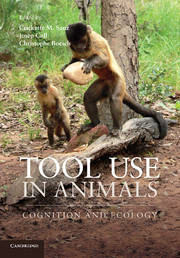Book contents
- Frontmatter
- Contents
- List of contributors
- Part I Cognition of tool use
- Part II Comparative cognition
- Part III Ecology and culture
- 8 The social context of chimpanzee tool use
- 9 Orangutan tool use and the evolution of technology
- 10 The Etho-Cebus Project: Stone-tool use by wild capuchin monkeys
- Part IV Archaeological perspectives
- Index
- References
10 - The Etho-Cebus Project: Stone-tool use by wild capuchin monkeys
from Part III - Ecology and culture
Published online by Cambridge University Press: 05 March 2013
- Frontmatter
- Contents
- List of contributors
- Part I Cognition of tool use
- Part II Comparative cognition
- Part III Ecology and culture
- 8 The social context of chimpanzee tool use
- 9 Orangutan tool use and the evolution of technology
- 10 The Etho-Cebus Project: Stone-tool use by wild capuchin monkeys
- Part IV Archaeological perspectives
- Index
- References
Summary
Tool use, according to St Amant and Horton (2008: 1203), is the “exertion of control over a freely manipulable external object (the tool) with the goal of altering the physical properties of another object, substance, surface or medium (the target, which may be the tool user or another organism), via a dynamic mechanical interaction.” Among wild great apes, only chimpanzees use tools habitually, in many varied formats across their geographical distribution, and for diverse purposes (see McGrew, 1992; Yamakoshi, 2004 for a review; Boesch et al., 2009; and this volume). Tool use is observed much less often in wild Sumatran orangutans (Pongo abelii), and even more rarely in the other wild great apes (Western gorillas, Gorilla gorilla, and bonobos, Pan paniscus), though in captivity all the great ape species use tools spontaneously in flexible and diverse ways. Among monkeys, very few species use tools in natural settings (Macaca fascicularis: Malaivijitnond et al., 2007; Gumert et al., 2009; Cebuslibidinosus and C. xanthosternos: Canale et al., 2009; for a comprehensive review concerning the genus Cebus, see Ottoni & Izar, 2008), although many species occasionally use tools in captivity (for reviews, see Anderson, 1996; Panger, 2007; Bentley-Condit & Smith, 2010; Shumaker et al., 2011). Among monkeys, the capuchins (species belonging to the newly identified genus Sapajus) excel in all respects (Bentley-Condit & Smith, 2010) and their tool use fully fits St Amant and Horton’s (2008) definition.
Tool-using skills of captive capuchins were reported in Europe in the sixteenth century (see Visalberghi & Fragaszy, 2012), long before the first illustration of a Liberian chimpanzee digging for termites appeared in a stamp issued in 1906 (Whiten & McGrew, 2001) or reached the scientific community through the work of Jane Goodall (1964). However, first-hand published reports on tool use by wild capuchins are relatively recent. Fernandes (1991) published the very first account of direct observation of tool use. He observed a wild capuchin (Cebus apella) using a broken oyster shell to strike oysters still attached to the substrate and successfully breaking them open. Boinski (1988) observed a wild male white-faced capuchin (C. capucinus) hitting a snake with a branch obtained from nearby vegetation. These observations each concerned one individual and one event. Habitual tool use (i.e., by several individuals over a period of time) in wild capuchins has been discovered and investigated only in the present millennium.
Information
- Type
- Chapter
- Information
- Tool Use in AnimalsCognition and Ecology, pp. 203 - 222Publisher: Cambridge University PressPrint publication year: 2013
References
Accessibility standard: Unknown
Why this information is here
This section outlines the accessibility features of this content - including support for screen readers, full keyboard navigation and high-contrast display options. This may not be relevant for you.Accessibility Information
- 30
- Cited by
